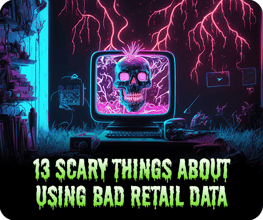Table of Contents
Today’s consumer packaged goods (CPG) sales directors face many challenges, including learning and managing the digital customer journey, maintaining profitable price points, and accurately forecasting sales to drive volume and ROI.
Quite often, success depends on effectively analyzing a myriad of demand and supply data to identify insights, patterns, and consumer trends that shape critical business decisions. However, for many sales leaders and their teams, gathering, organizing, and examining the data feels like walking blindly through a maze, with the pathway to the end-goal convoluted and confusing.
HITTING A WALL
The typical sales director, as well as account teams, must wind through various complicated scenarios:
- Managing thousands of retailer accounts with a wide range of consumer bases
- Data mining from a multitude of disparate and dysfunctional sources
- Dealing with uncertainty about where inventory sits or if it exists at all–and if retail replenishment can occur in a timely fashion
- Battling with internal systems, applications, and tools that don’t speak to each other
- Struggling with demand forecasting and planning strategies that include too much guesswork
- Deciphering point-of-sale and inventory data that are incomplete, too complex, arrive too late or lack sufficient granularity for initiating improvements
PERFORMING A CRAZY DANCE
In many cases, those who oversee sales or national and key account teams feel like they are involved in a crazy dance. They can’t always be certain of what’s helping product turns and what’s not. As a result, they’re faced with difficult decisions that could be costly for both the supplier and retailer. If their customers aren’t moving through inventory the way they should, sales needs to take action. But without the right data, analytics, and insights, they wonder: “Do we need a new promotional strategy? Should we modify our door strategy? Do we need to adjust our pricing?” They try to predict what will turn their product to hit gross margins and ensure liquidity.
How the product is trending in the market is another vital concern for ensuring supply meets consumer demand. For instance, how many sweaters are needed to fill the stock model for a particular account. However, it takes time—and patience—to pull, assemble, and analyze data. And more often than not, by the time the information is gathered, the sales lead is not even sure what to do with it since it’s latent and often inaccurate. At this point, accurate sales forecasting and decision-making become conjecture at best.
THE NEED FOR SPEED
Complicating the decision-making process is the need to make accurate performance and inventory analyses quickly. Retailers want agility in their warehouses—the ability to move product quickly and the option to ship product instantaneously. To do so, information is needed daily—not weekly or monthly.
Pressure builds to make intelligent decisions on the spot. Perhaps 3,000 units of lawn furniture are not moving. Should they be marked down, taken off the floor, or shipped to another store or retailer? How will the fast-approaching new season impact this? Are more drastic measures needed such as liquidation?
USING AN OMNI LENS
Omnichannel retailing is now the gold standard for retail success. Providing customers with a personalized brand and shopping experience, seamless across any digital or brick-and mortar touchpoint, is imperative. What the sales director needs is an “omni lens” to get a holistic view of the consumer’s entire journey—from brand discovery to purchase and brand loyalty. The solution, once again, is dependable data that will provide insight into making the buyer’s journey smooth and satisfying.
Reviewing data in an Excel report is not enough. Salespeople need to know the profit margin clearly and simply to formulate a credible pricing strategy. More than being mindful of what the numbers are is understanding what they mean, what generated them, and how sales targets will be reached—profitably. Unfortunately, these calculations and decisions can end up being made haphazardly on a napkin—a risky way to do business.
BRAND VALUE IS THE KEY
Yes, sales are essential to both CPG manufacturers and retailers, but the most important thing to a CPG sales director is the value and integrity of the brand and how the brand can best be represented. Without this, consumers will have no interest in buying a product or remaining loyal to a label.
To best represent the brand requires understanding two things: First, the nature of the business from every angle and, second, who your consumers are, providing them with what they need and value—when they want and need it.
Okay, so maybe timely, accurate, daily data is not a matter of life and death. But it can make a huge difference in the life and survival of your brand and company. Relief comes when sales, marketing, and supply chain teams work in unity—with harmonized data—to craft intelligent business decisions that create a financially bright and healthy today and tomorrow.
If you'd like to learn how to turn your data into a business asset and not a liability, contact us today.




